Pass the Buck

Bill Cullen hosted oodles of game shows, some of which lasted for years. Pass the Buck was one of his biggest flops, debuting on CBS in April of 1978 and disappearing thirteen weeks later.
Here’s how it worked: Four players competed, answering questions that had multiple answers like, “Name a U.S. president who served two terms” or “Name a flavor of ice cream sold at Baskin-Robbins.” If the first player gave an acceptable answer, as determined by the program’s judges, $25 was added to the bank and the play passed to the second player. If the second player took too long or gave an unacceptable answer, he or she would be eliminated if the next player answered correctly. Eventually, three of the four players would be eliminated and the remaining player would win all the money then in the bank and a chance at the bonus round which no one seemed to understand.
The producers kept fiddling with the rules, especially with that bonus round, but time ran out for Pass the Buck before they got the bugs out.
Hot Potato
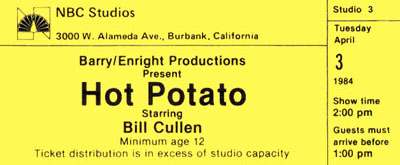
Hot Potato was the last network game show hosted by Bill Cullen (he did several for syndication later) and one of his least successful. It aired on NBC from January of 1984 through June of the same year. The quiz pitted two teams against each other, each team comprised of three people who had something in common — three firemen, for example. Or three former beauty queens or something of the sort. Later, when it was clear the show wasn’t working, they abandoned that idea and each team was made up of two celebrities and a civilian, with the non-celeb taking home whatever the team won.
The game itself had a bit of Family Feud in it. The show conducted a survey on some question of vital interest like, “What’s your favorite pizza topping?” The idea then was to identify the seven most popular responses to the question. When it was your team’s turn, you could either try to answer or you could challenge someone on the opposite team to answer. If they couldn’t, they were eliminated. So your team could win the round one of two ways: You could give the seventh answer or you could knock out all three players on the opposing team. If you won two out of three games, you got to play a bonus round for more cash.
After long associations with Goodson-Todman and Bill Stewart Productions, this was Cullen’s first game show for the Barry-Enright production company. He went on to host The Joker’s Wild for them in syndication.
Child’s Play
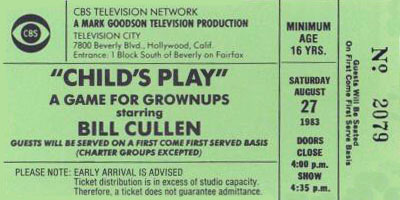
Another game show hosted by Bill Cullen. This one ran on CBS for one year — September of ’82 to September of ’83. The premise was pretty simple: A film crew went out and interviewed children, asking them to define different words. In the studio, two contestants were shown excerpts from those interviews and asked to guess the word that the kiddos were discussing. It sounds better here than it did on the screen where the whole thing came off as awkward and contrived, and sometimes even a bit condescending to the children. Cullen soldiered on bravely with the show but you could almost tell that he knew this one wasn’t working. It reportedly stayed on the air as long as it did only because the network had trouble coming up with a replacement that seemed like it might fare better. When they found Press Your Luck, they said bye-bye to Child’s Play.
Blockbusters
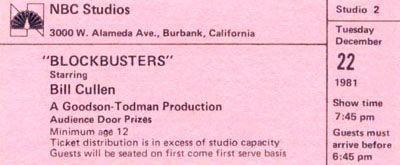
Another in the seemingly-endless list of game shows hosted by Bill Cullen, Blockbusters aired on NBC from October of ’80 until April of ’82. The most unusual thing about it was that it pitted a two-person team against a single player. In order to win a round, the two-person team had to answer a few more questions than the single player, and my impression was that this didn’t happen very often. It always seemed like the single player was victorious.
The questions involved identifying words or names from initials. The player (or players) would pick a letter from the game board — “L,” for example. Cullen would then ask them, “What L would you associate with a candelabra?” The correct answer in this case was Liberace. In the bonus round, wherein serious money could be won, the questions would often be abbreviations: “This G.W.T.W. won many Academy Awards.” To that, the conestant(s) would have to answer, “Gone With the Wind.” And so on.
It was a pleasant little game, carried mainly by Mr. Cullen’s genial nature. It was not the best of the many game shows he hosted but it was one of the better ones. Not long after it went off the air, he was back on the air — this time on CBS — with Child’s Play.
Three on a Match
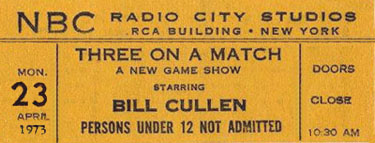
A little less than two years after Eye Guess was cancelled, its producer (Bob Stewart) and host (Bill Cullen) and much of the same staff were back on NBC with Three on a Match. This one debuted in August of ’71 and lasted until June of ’74.
What was it about? That’s hard to say. It was even hard to say when it was on because the rules were complex and they kept changing. Basically, three players competed. They were shown a list of categories and they’d pick one and wager on how many true-false questions they thought they could answer in that category. With the cash they’d win by doing that, they’d buy squares on a big game board where pictures of prizes were hidden. If they revealed three matching prize pictures, they’d win that prize. Or at least, that’s how it went for a while. This was a confusing game and its producers were forever altering the rules to make it into smooth-running, simple affair.
They never quite managed that and at some point, it was apparently decided that it was easier to just chuck the whole thing and start over. So the last episode of Three on a Match aired on Friday, June 28, 1974. The following Monday, the exact same staff — including producer Stewart and star Cullen — were doing a new game show called Winning Streak in the same time slot on NBC.
Eye Guess
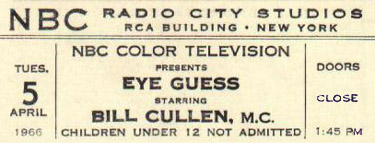
Eye Guess was the first independent production of Bob Stewart, a game show producer who’d previously worked for Goodson-Todman Productions where he’d supervised and/or developed hits including To Tell the Truth, Password and the original The Price is Right. On the last of these, which had just been cancelled after its long run, Stewart worked with emcee Bill Cullen, and when Stewart struck out on his own, he tapped Cullen to host his first show.
On Eye Guess, two players confronted a game board containing nine squares like a tic-tac-toe game. In round one, they’d be shown eight possible answers to upcoming questions…but only for eight seconds. Then as Cullen asked questions, they’d call out numbers — i.e., “The answer to that one is behind Number Six, Bill!” Sometimes, the correct answer was none of the eight and if they thought that, they’d select the middle square, which was the “Eye Guess” space. If you racked up enough correct guesses, you won. Simple as that.
Eye Guess was a modest hit, lasting on NBC from January of ’66 to September of ’69. Cullen was not idle for long. The same month Eye Guess went off, Goodson-Todman revived To Tell the Truth as a daytime show and included him on its panel. Two years later, he was also back as a host…on a new NBC game show, Three on a Match, also produced by Bob Stewart.
Ernie Kovacs Show, The (1955-1956)
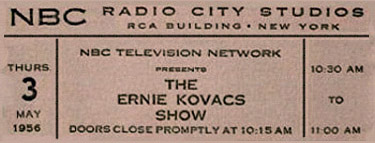
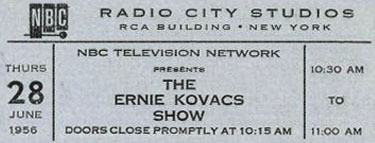
Ernie Kovacs spent much of the fifties wandering from network to network and show to show, doing essentially the same program. The critics loved him and his innovative brand of comedy. Audiences liked him but not enough to make any one show enough of a hit that he stayed in one gig for very long.
Today, when you see clips of his work, the emphasis is on silent bits that pushed the envelope of what was technically possible in television at that time. I always thought those compilations, though impressive, missed the point of Kovacs. First of all, a lot of the visual stuff was his wholly the work of his writers. (Kovacs isn’t even in some of the most-seen excerpts.) Secondly, some of them are merely a matter of replicating in a TV studio bits that had previously been done on film by Buster Keaton or Harold Lloyd or even — in the case of one clip in particular — The Three Stooges. That’s the one where he’s sitting on a tree branch, sawing off the branch he’s sitting on…and the tree falls while the branch remains in the air.
The clips that suggest Kovacs was worthy of his exalted reputation are the ones where he talks…as one of his characters (like the effeminate poet, Percy Dovetonsils) or even as Ernie Kovacs. He was a very funny man without the gimmicked props and the trick photography.
No one ever seems to have compiled a definitive list of all the shows that Kovacs starred in over the years. Some did not last long and there were even times when he was doing two shows at the same time. Most articles about him, for instance, will tell you of an hour-long prime-time series he did on Monday nights for NBC from December of 1955, lasting until the following September. It was called The Ernie Kovacs Show but the above tickets are from a rarely-mentioned half hour daily morning show with the same name that he was doing during the same period. At some point in there, he stopped doing the morning show and was filling in for Steve Allen on Tonight.
Later on, there were other shows…on and off, here and there, until his death in a car crash in 1962. It robbed TV viewers of one of the funniest human beings they ever got to follow from show to show.






